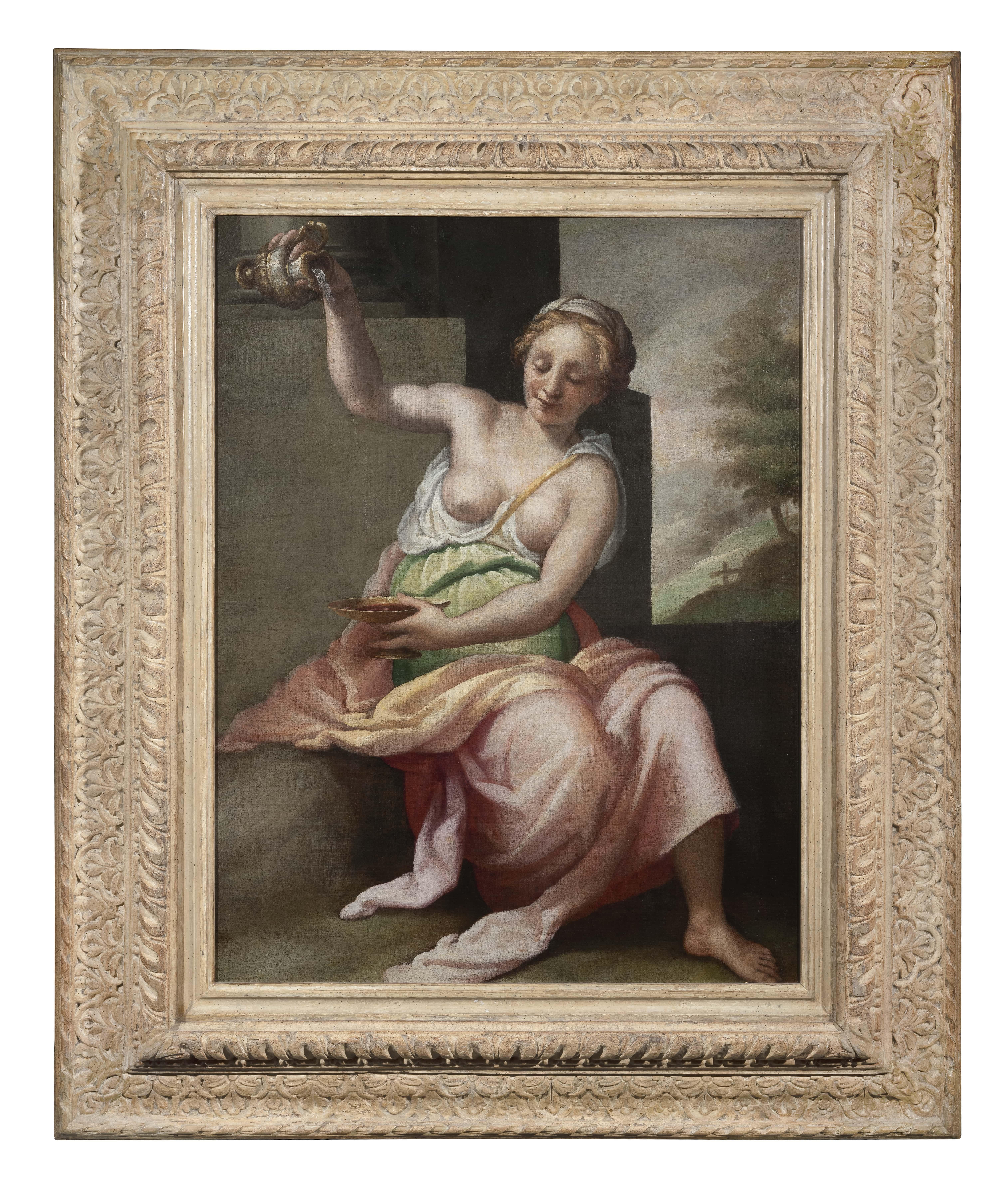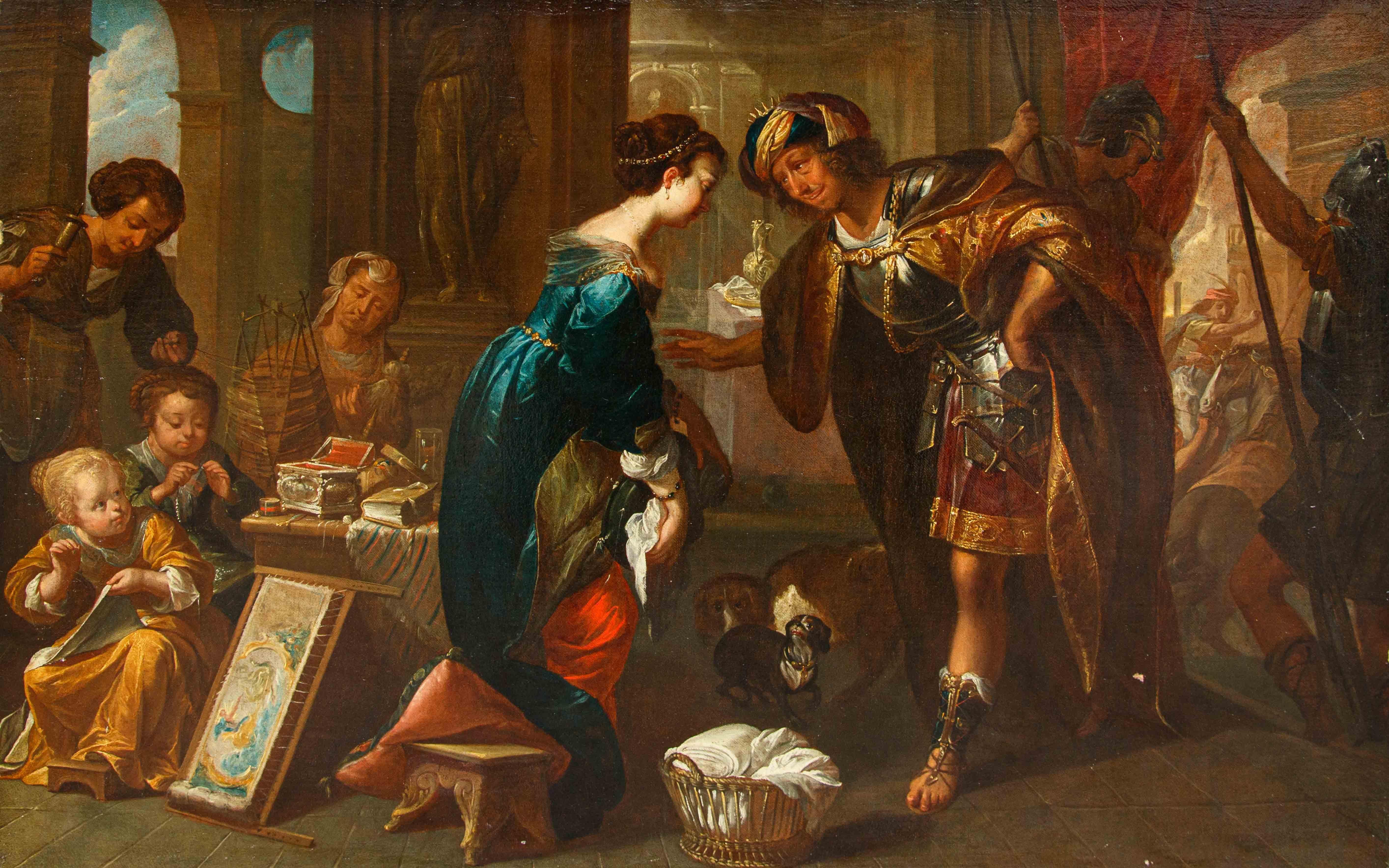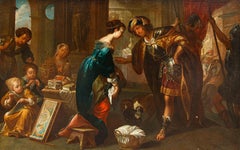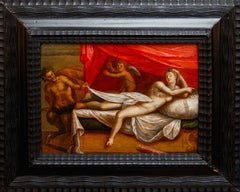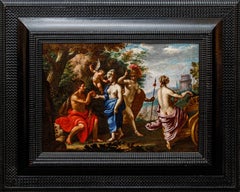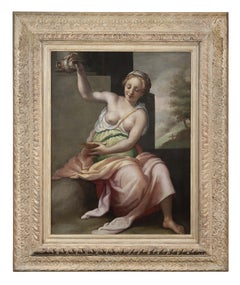Items Similar to Scope of Abraham Janssens (Antwerp, 1573- Amsterdam, 1632), Magdalene
Want more images or videos?
Request additional images or videos from the seller
1 of 13
Scope of Abraham Janssens (Antwerp, 1573- Amsterdam, 1632), MagdaleneXVII Century
XVII Century
$4,158.87
£3,091.64
€3,500
CA$5,720.74
A$6,373.75
CHF 3,361.54
MX$77,271.41
NOK 42,763.59
SEK 39,837
DKK 26,664.60
About the Item
Scope of Abraham Janssens (Antwerp, c. 1573/1574 - Amsterdam, 1632)
Magdalene in prayer
Oil on copper, 35 x 27 cm
Framed, 50 x 44 cm
Abraham Janssens, who was born in Antwerp around 1573-1574 and died in Amsterdam in 1632, is a fascinating and, in some ways, unjustly neglected figure in the panorama of Flemish Baroque art. Although his name is often overshadowed by the greatness of Peter Paul Rubens, Janssens was a significant innovator, a remarkably talented painter who played a crucial role in the transition from Mannerism to Baroque, especially in history painting in Flanders. His artistic training took place in Antwerp, where he was a pupil of Jan Snellinck the Elder. This apprenticeship laid the foundation for a career that would see him emerge as one of the leading painters of his generation. A trip to Italy, probably between 1597 and 1602, was a key formative moment. In Rome, Janssens had the opportunity to engage with the works of the Renaissance masters and, crucial to his development, with the emerging Caravaggism. The influence of artists such as Caravaggio and Annibale Carracci is evident in his later production, particularly in his predilection for sculptural modeling and dramatic use of light. Upon his return to Antwerp, Janssens quickly established himself as master of the Guild of St. Luke in 1602-1603. It was a time of great artistic ferment in the city, and Janssens found himself competing and collaborating in a dynamic environment. His early works, such as the "Stairway of Virtue" (ca. 1605) or "Diana and Callisto" (ca. 1601), still show Mannerist reminiscences, but already reveal an attention to the monumentality of figures and a compositional clarity that prefigure the Baroque. His style matured rapidly, and between 1606 and 1612, Janssens produced some of his most significant works, characterized by a sculptural robustness of the figures, strong, directional lighting, and an ability to express dramatic pathos. Excellent examples from this period include "Skeleton with Sickle, the Three Fates and a Young Girl" (1608), an allegory of the transience of life, and especially "Climb to Calvary" (1609-1610), a work of great emotional and compositional impact. A distinctive aspect of Janssens' art is his emphasis on physicality and anatomical rendering, often with a tendency toward heroism in the figures. This distinguishes him to some extent from Rubens, whose style was more oriented toward fluidity of movement and chromatic brilliance. Janssens, on the other hand, favored a more restrained and earthy palette, and his compositions, while dynamic, retained a certain monumental, almost sculptural stillness. The rivalry, or at least the comparison, with Rubens is an inescapable element in Janssens' biography. Both were leading artists in Antwerp, and although Rubens eventually prevailed in terms of fame and large-scale commissions, Janssens retained a significant role, especially for works on religious and mythological subjects intended for an educated clientele. Interestingly, both artists helped define the Flemish Baroque language, but with distinct stylistic approaches. In the later years of his career, Janssens' style became less rigorous and more influenced by the trends of the time, in part because of the rise of Rubens. However, his importance as a pioneer cannot be underestimated. He was one of the first to bring the vigor of Italian naturalism to Flanders, paving the way for future generations of painters. Abraham Janssens was an artist of depth and complexity whose work deserves reconsideration. His ability to blend the monumentality of the Roman Renaissance with the dramatic intensity of Caravaggism makes him a key figure in understanding the development of the Flemish Baroque. Although he did not achieve the universal fame of Rubens, his output is a testament to his mastery and fundamental contribution to art history.
Our painting takes up one of the most successful models of Abraham Janssens' painting; that of the Magdalene at prayer in fact turns out to be one of the iconographic modules most taken up by his pupils and followers. The painting shows a female figure, identifiable as Mary Magdalene, sitting in a pensive and devout pose. His gaze is upward, with an expression of deep contemplation or prayer, and his eyes seem slightly reddened, suggesting tears or intense fervor. The woman is richly dressed in clothes that, while denoting a certain luxury, are presented in a way that recalls her past worldly life before her conversion. She wears a white or cream robe under a dark bodice, and a wide golden yellow drape wraps around her shoulders and arms, creating voluminous and luminous folds. On his arms he wears gold bracelets, and around his neck several necklaces, one of which is adorned with red and gold beads and pendants. Her long dark hair falls loosely over her shoulders. On the head, a small red floral decoration completes the hairstyle. The scene is set in a dark, almost bare interior that emphasizes the central figure. On the right side of the painting, at the bottom, some attributes typical of depictions of Mary Magdalene and vanitas are visible: a human skull, a symbol of mortality, and several precious objects such as jewelry and perhaps a crown or tiara, representing earthly possessions abandoned in favor of spirituality. An urn or jar of ointments, another iconographic attribute of Magdalene, may be just visible in the background on the right. The dramatic lighting is clearly Caravaggio-derived, with light seemingly coming from the upper left, illuminating the face, chest, and yellow drape, creating strong contrasts between the lit and shaded areas. This chiaroscuro accentuates the emotional depth and spirituality of the scene, typical of Baroque art in Italy as well as north of the Alps. The brushwork appears rich and textural, especially in the rendering of textiles and jewelry.
- Creation Year:XVII Century
- Dimensions:Height: 13.78 in (35 cm)Width: 10.63 in (27 cm)
- More Editions & Sizes:cm 35 x 27Price: $4,159
- Medium:
- Circle Of:Abraham Janssens (1575 - 1632, Flemish)
- Period:
- Condition:
- Gallery Location:Milan, IT
- Reference Number:1stDibs: LU2639216764012
About the Seller
No Reviews Yet
Vetted Professional Seller
Every seller passes strict standards for authenticity and reliability
1stDibs seller since 2023
Typical response time: <1 hour
- ShippingRetrieving quote...Shipping from: Milan, Italy
- Return Policy
Authenticity Guarantee
In the unlikely event there’s an issue with an item’s authenticity, contact us within 1 year for a full refund. DetailsMoney-Back Guarantee
If your item is not as described, is damaged in transit, or does not arrive, contact us within 7 days for a full refund. Details24-Hour Cancellation
You have a 24-hour grace period in which to reconsider your purchase, with no questions asked.Vetted Professional Sellers
Our world-class sellers must adhere to strict standards for service and quality, maintaining the integrity of our listings.Price-Match Guarantee
If you find that a seller listed the same item for a lower price elsewhere, we’ll match it.Trusted Global Delivery
Our best-in-class carrier network provides specialized shipping options worldwide, including custom delivery.More From This Seller
View AllFrom Paolo Veronese, Allegory of Strength and Wisdom
By Paolo Veronese
Located in Milan, IT
Follower of Paolo Veronese (Verona, 1528 - Venice, 1588)
Allegory of wisdom and strength
Oil on canvas, 48 x 36.5 cm
Picture frame, 61 x 48 cm
The Allegory of Wisdom and Strength...
Category
16th Century Other Art Style Figurative Paintings
Materials
Canvas, Oil
By Jan van den Hecke (Kwaremont, 1620 - Antwerp, 1684), Tarquin and Lucretia
Located in Milan, IT
Monogrammer I.H., identifiable with Jan van den Hecke (Kwaremont, 1620 - Antwerp, 1684)
Sextus Tarquinius surprises Lucretia at work
Oil on canvas, 66 x 100 cm
Framed, 79 x 112 c...
Category
Late 17th Century Other Art Style Figurative Paintings
Materials
Canvas, Oil
Lambert Sustris's workshop (1515-1520 - c. 1584), Venus and Love Spied on
Located in Milan, IT
Lambert Sustris workshop (1515-1520 -approximately 1584)
Venus and Love spied on by a satyr
Oil on panel, 24 x 32 cm
Framed, 41 x 49 cm
The tablet described here, which can be at...
Category
18th Century and Earlier Other Art Style Figurative Paintings
Materials
Canvas, Oil
Girolamo Maria Pesci (Rome, 1679 - 1759), The judgment of Paris
Located in Milan, IT
Girolamo Maria Pesci (Rome, 1679 - 1759)
The judgment of Paris
c. 1705-1710
Oil on canvas, 47 x 36.5 cm
Girolamo Maria Pesci (Rome, 1679 - 1759), a figure distinguished for his e...
Category
18th Century and Earlier Other Art Style Figurative Paintings
Materials
Canvas, Oil
After Peter Paul Rubens, Allegory of Abundance
By (After) Peter Paul Rubens
Located in Milan, IT
Rubensian school, 17th century
Allegory of abundance
Oil on panel, 30.5 x 45 cm
With frame 38.5 x 55 cm
Category
17th Century Other Art Style Figurative Paintings
Materials
Canvas, Oil
Carstian Luyckx (c. 1627-1675), Still life with parrot and monkey
Located in Milan, IT
Carstian Luyckx (c. 1627-1675)
Still life with parrot, monkey and character behind window
Oil on canvas, 121 x 92 cm
Framed, 145 x 115 cm
This magnificent canvas represents a Fle...
Category
17th Century Other Art Style Still-life Paintings
Materials
Canvas, Oil
You May Also Like
Early 17th Century by Abraham Janssens The Gypsy Oil on canvas Old Master Art
Located in Milano, Lombardia
Abraham Janssens (Antwerp, Belgium, 1573 - Amsterdam, the Netherlands, 1632)
Title: The Gypsy
Medium: Oil on canvas
Dimensions: without frame 116 x 94 cm – with frame 148 x 122 cm
Co...
Category
Early 17th Century Old Masters Figurative Paintings
Materials
Oil, Canvas
Late 16th Century by Jacopo da Empoli Temperance Oil on canvas
Located in Milano, Lombardia
Jacopo da Empoli (Florence, Italy, 1551 – 1640)
Title: Temperance
Medium: Oil on canvas
Dimensions: without frame 101.5 x 75.7 cm – with frame 140 x 115.3 x 10.50 cm
Expertise by Al...
Category
16th Century Old Masters Figurative Paintings
Materials
Canvas, Oil
17th Century by Giovanni Domenico Ferrucci The Death of Cleopatra Oil on canvas
Located in Milano, Lombardia
Giovanni Domenico Ferrucci (Fiesole, Italy, 1619 – Lucca, Italy, post 1669)
Title: The Death of Cleopatra
Medium: Oil on canvas
Dimensions: without frame 85 x 70.7 cm – with frame 10...
Category
17th Century Old Masters Figurative Paintings
Materials
Canvas, Oil
Terwesten Woman Allegory Art Paint Oil on canvas 17/18th Century Old master
Located in Riva del Garda, IT
Mattheus Terwesten (The Hague, 1670 - 1757)
Portrait of a young woman with palette and brushes, as Allegory of the art of Painting
Oil on canvas
160 x 91 cm. - In frame 178 x 107 cm...
Category
17th Century Old Masters Paintings
Materials
Oil
$11,739 Sale Price
20% Off
Pier Francesco Cittadini (Milanese master) - 17th century figure painting - Lady
By Pier Francesco Cittadini
Located in Varmo, IT
Pier Francesco Cittadini (Milan 1616 - Bologna 1681) attributed - Portrait of a Lady.
80 x 61 cm unframed, 91 x 70 cm with frame.
Oil on canvas, in a gilded wooden frame (not signe...
Category
Mid-17th Century Baroque Portrait Paintings
Materials
Canvas, Oil
17th Century by Giacomo Sementi and Pier Francesco Cittadini Danae Oil on Canvas
Located in Milano, Lombardia
Giovanni Giacomo Sementi (Bologna, Italy, 1580 - Rome, Italy, 1636) - Pier Francesco Cittadini (Milan, Italy, 1616 - Bologna, Italy, 1681)
Danae
Oil on canvas, without frame 119 x 179 cm, with frame 140 x 200 x 12 cm, weight 35 kg
Expertise by Professor Giancarlo Sestieri
Publications: Carne - la materia dello spirito, exhibition catalogue curated by Father Alessio Geretti, project of the scientific catalogue curated by Father Alessio Geretti, Nicole Pravisani and Giulia Toffoletti, (21 May - 22 October 2023), Illegio, Casa delle Esposizioni, pp. 56-59; Body, Love and Feelings - Works of Ancient Masters from the 16th to the 19th century. In the paintings of Giorgio Baratti private collection, Milan, exhibition catalogue curated by Alessandro Marchi, (27 July - 18 September 2011), San Marino - Historical Centre, pp. 38-39; Giorgio Baratti Collezione. Selezione di opere d’arte antica (Giorgio Baratti Collection. Selection of ancient works of art), curated by Professor Giancarlo Sestieri and with the participation of Professor Andrea Emiliani, Grafiche Veneziane, Venezia 2011, pp. 22-23.
It is a gentle and graceful Danae the one portrayed by Giovanni Giacomo Sementi. A painting in which the Milanese painter Pier Francesco Cittadini also collaborated by painting the golden basin filled with flowers to the left of the scene. The work shows various pictorial influences; from the Bolognese Emilian style, to that of Ludovico Carracci (1555 - 1619) and Guido Reni (1575 - 1642), to the Baroque and Roman style. The work features an elegant red drapery which serves as the background to the entire scene, but the real protagonist is the young woman with long red hair who is lying on a bed covered by a white sheet. The girl is naked except for a lapis lazuli blue mantle...
Category
17th Century Old Masters Figurative Paintings
Materials
Oil, Canvas

